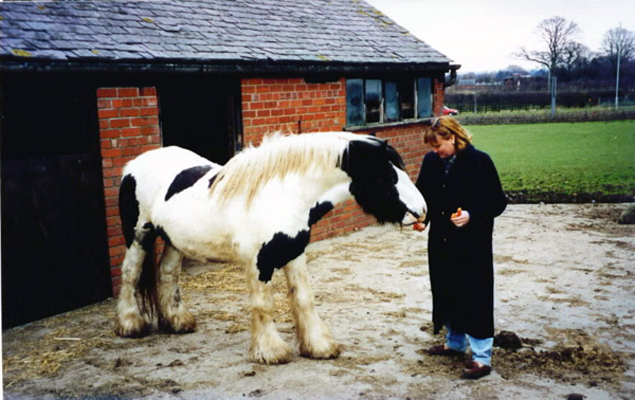The Gypsy Vanner Horse Profile
Beautiful and magical! Is the Gypsy Vanner the horse of your dreams?
by Raina Paucar
Can you recognize the distinctive Gypsy Vanner horse? You may have seen these beautiful horses in a variety of equestrian pursuits, including driving, English and western riding, jumping, dressage, pleasure and trail.
Equitrekking interviews Dennis Thompson, the original importer of the first Gypsy Vanners brought to America, and owner of Gypsy Gold, the original home of the Gypsy Vanner Horses in Ocala, Florida. Dennis Thompson is also the founder of the Gypsy Vanner Horse Society. He shares his story of the discovery of the Gypsy Vanner and what makes this breed so unique among horses.
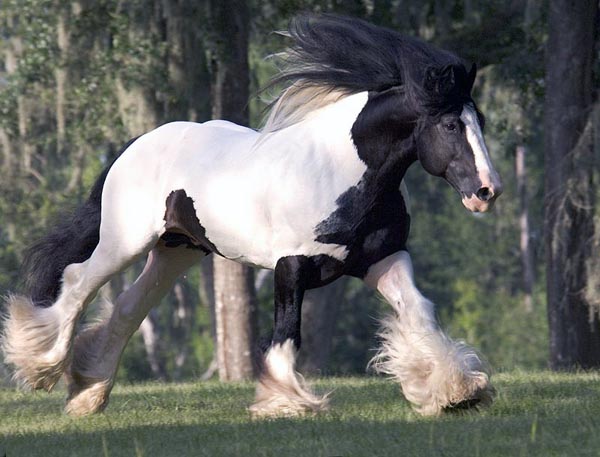
"The Gypsy King," one of the first Gypsy Vanner stallions to come to America / Photo courtesy of Mark Barrett
Equitrekking: What was the original goal of Gypsy Vanner as a breed?
Dennis Thompson: Soon after World War II, a vision was born by the Gypsies of Great Britain to create the perfect caravan horse, “a small Shire, with more feather, more color and a sweeter head."
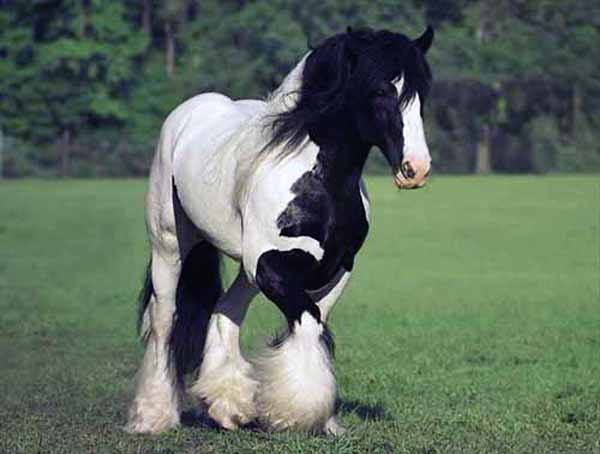
"The Gypsy King," a Breyer Horse and Vogue model for the Gypsy Vanner breed / Photo courtesy of Mark Barrett
Equitrekking: How and where did you discover the Gypsy Vanner?
Dennis Thompson: Selective breeding continued virtually unknown to the outside world for over half a century until two Americans, Cindy and I were traveling through the English countryside and noticed a magical looking horse standing in a field.
Cindy Thompson with "Custi Bok," on the day of his discovery / Photo courtesy Dennis Thompson
It was that very horse that became the key to unlocking the heretofore-unknown vision and genetics that created the Gypsy Vanner breed. Be it good fortune, good luck or pure Gypsy magic, a passion was born in us to understand the little stallion that captured our attention and stole our hearts. It would take years to learn about this special horse and the colorful culture that had created it.
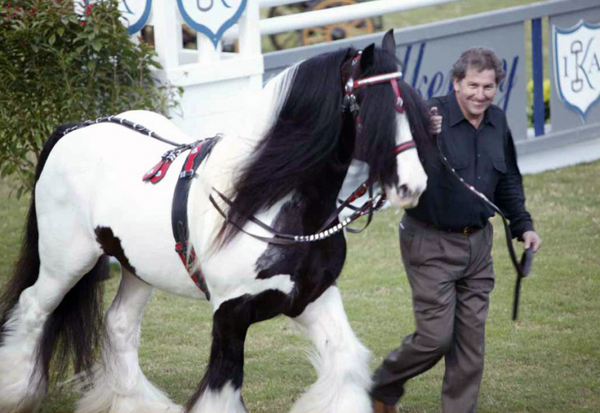
"The Gypsy King" and Dennis Thompson
Invited by the stallion’s owner, we became the first American’s ever to attend the oldest Gypsy horse fair in the world (Appleby) with the sole purpose of developing a better understanding of Gypsies and their horses.
For ten days we introduced ourselves to every Gypsy who bought or sold a quality looking horse and then documented the contact information for a later pursuit. The discovery of one special little stallion and ten days of open-eyed wonder turned a passion to understand Gypsies and their horses into an obsession that would last the next four calendar years.
With the approval of Gypsies, we named the unknown, unnamed breed the Gypsy Vanner Horse. Vanner in the English Chambers Dictionary meant, "A horse suitable to pull a caravan," until 1996 when it was removed from lack of use. the same year we imported the Vanner breed.
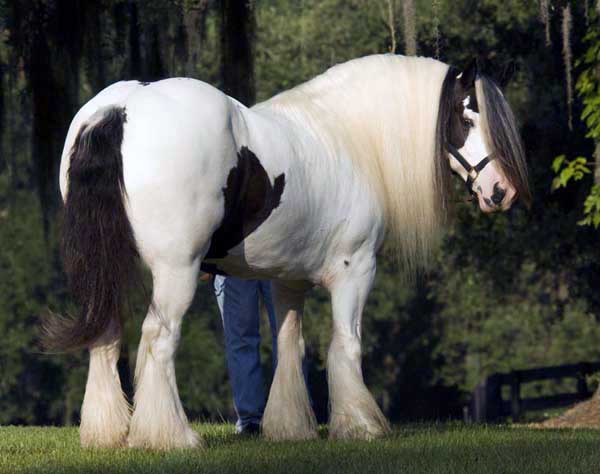
Shampoo Girl, one of the first fourteen Gypsy Vanners to come to America–Dam of BB King (America's first born solid colored Vanner) / Photo courtesy of Mark Barrett
Returning from our fateful trip, Cindy and I sat on a plane contemplating the absurd possibility that we may have just stumbled upon an unknown breed of horse in the last decade of the twentieth century. As wildly improbable as it seemed, research brought us closer and closer to the reality that this was in fact one of the most magnificent breeds of horse the world has ever seen, but not recognized, named or understood outside the world of Gypsies. I cannot explain or express deeply enough the sense of responsibility that realization brought with it.
Our pursuit to learn more about the Gypsy Vanner resulted in:
- Tracing the little stallion’s genetic heritage through three countries; Gypsies focused on a vision to create horses with the little stallion’s specific look–raised all.
- Uncovering the heretofore-unknown post World War II vision from which the breed was born.
-
Identifying the two stallions that inspired the Vanner breed, “Sonny Mays” and “The Coal Horse.”
-
Identifying many of the influential stallions and mares originating from Sonny Mays and The Coal Horse that came over the next half century.
-
Discovering that the little stallion that had inspired our journey was in fact (as a yearling) the most highly prized colt in all of Great Britain at the same 300-year-old horse fair where our quest for knowledge began.
-
Identifying the genetics that created the breed. Shire-Clydesdale-Dales Pony-Friesian.
- Writing the mission statement and goals of the Gypsy Vanner Horse Society.
Equitrekking: What kind of temperament is this breed best known?
Dennis Thompson: The Gypsy Vanner Horse is often compared to a companion animal because they want to please and be with people so much. This unusually affectionate behavior is most surprising to visitors to our farm who have had horses all their lives! We believe that the Vanners' innate kindness is attributed to two factors –– feather and environment. I call them a Golden Retriever with hooves.

Bat and Dolly North America's first Gypsy Vanner Horses stepped hooves on American soil Nov 24,1996 / Photo courtesy of Mark Barrett
Equitrekking: What are the origins of the Gypsy Vanner Horse Society (GVHS)?
Dennis Thompson: Founded November 24, 1996 the GVHS is the world’s first registry to recognize a breed of horse developed by the Gypsies of Great Britain/Ireland and the only such registry founded on an in depth study of British/Irish Gypsies and their horses.
All breeds result from a crossing of breeds by someone or some culture focused on creating a specific looking horse born from their dream image – their vision. Once the horse is achieved and recognized, the basic function of a breed society is to protect, educate, perpetuate and promote the breed. With the Gypsy Vanner's magic and colorful heritage, the opportunity is even greater.
Equitrekking: What is the mission of Gypsy Vanner Horse Society?
Dennis Thompson: To bring honor recognition and a better understanding to one of the worlds most colorful, least understood societies and the horses they so dearly love by respecting the spoken words of Gypsies who have dedicated lifetimes in the pursuit of a dream to create their perfect caravan horse, to remain quality based, culturally sensitive and socially responsible.
In addition we established four goals:
- Establish the breed with the look Gypsies envisioned.
- Establish the breed with the DNA verified genetics that created the look they envisioned whenever possible.
- Establish the breed with the feelings of status and pride that Gypsies only feel for their selectively bred horses.
- Establish the breed in direct parallel to the values Gypsies place on their selectively bred horses.
- Only 20% of the horses that Gypsies raise are selectively bred, 80% are of unknown heritage.
The mission and goals of the Gypsy Vanner Horse Society were inspired by a deep sense of responsibility and a sincere desire to establish the magical looking breed Gypsies envisioned and created without changing a thing.
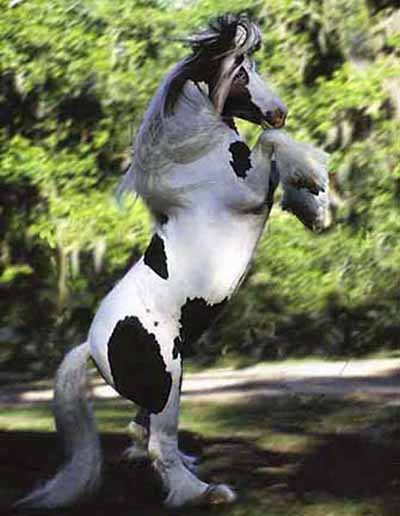
"Custi Bok," the first selectively bred and recognized Gypsy Vanner developed by British Gypsies / Photo courtesy of Mark Barrett
To learn more about the Gypsy Vanner horses visit: www.Vanners.org or www.GypsyGold.com
